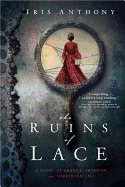
Banned by King Louis XIII, yet highly desired by courtiers and merchants, Flemish bobbin lace was both currency and contraband in 17th-century France. Through seven points of view, Iris Anthony weaves the intricate story of a single length of lace and its impact on many lives in The Ruins of Lace.
Katharina has woven lace under the watchful eyes of nuns until she has nearly lost her own sight, but she cannot imagine doing anything else. Since Lisette incurred the wrath of a visiting count, he has threatened her family with ruin unless they can provide the lace he craves. Denis, a border guard, struggles to understand lace's appeal, while a dog used to run lace from Flanders to France understands only that lace must be very important to humans. These and other stories begin as separate threads, but Anthony weaves them together until each strand becomes essential to the novel's overall pattern.
The complex plot is the strongest feature of The Ruins of Lace; the multiple narrators make it difficult to get a clear picture of any one character. However, the historical detail is fascinating, from the methods used to run lace (coffins, dogs, hollowed-out loaves of bread) to the strict social boundaries expressed through fabrics, weapons and household goods. The abrupt ending feels as though Anthony snipped off all seven threads at once, but the glimpse she offers into the 17th-century's passion for fine lace are both intriguing and entertaining. --Katie Noah Gibson, blogger at Cakes, Tea and Dreams

